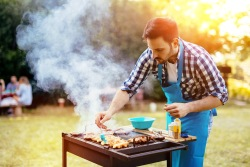If you’re in the market for a new braai, first you need to answer the age-old question: which grill to buy, charcoal or gas?
 Better gas braais generally have two or more separate burners which allow greater heat control.
Better gas braais generally have two or more separate burners which allow greater heat control.Well in short, it's a lifestyle choice. This is really your first decision. Are you convinced there's nothing like the taste and smell of food braaied over hot coals? Do you take a certain pride in your ability to get the fire started and keep it properly tended while you cook? Do you need that hands-on, primal experience? Or do you want a perfect fire at the push of a button? Do you appreciate the precision temperature adjustments gas braais can provide? Would you rather avoid the whole charcoal set-up and the post-cookout ashes?
Amy Whittam, Marketing Manager from Weber, says whether you're in the charcoal or gas braai camp, you're in luck. Taste tests indicate that there's no significant flavour difference either way. The choice is strictly personal.
She says consider how you plan to use your braai - will you braai almost every night or just on special occasions? Will that change over time? Is cost an issue? While gas braais are initially more expensive, they generally cost less to operate in the long run. Both are great choices, pick the one that's right for you.
 A well-built gas or charcoal braai will feel solid and sturdy while a poorly made braai will wiggle.
A well-built gas or charcoal braai will feel solid and sturdy while a poorly made braai will wiggle.Amy shares some key features you need to look for when deciding on either a gas or charcoal braai.
1. The cooking system
Better gas braais generally have two or more separate burners which allow greater heat control. Typically, one burner braais don't allow you to control heat as well as braais with multiple burners.
The best braais also use a steel bar system that funnels grease away from the burner flames, which greatly reduces flare-ups.
2. British thermal units or BTUs
BTUs are not a measure of cooking power. They indicate the volume of gas a braai can burn. Tightly engineered braais use fewer BTUs and cook food more efficiently.
Sometimes less is more. Too many BTUs can cause damage to burners and reduce the life of the braai. In general, large braais with large cooking surfaces require higher BTUs.
3. Solid construction
 The best braais also use a steel bar system that funnels grease away from the burner flames, which greatly reduces flare-ups.
The best braais also use a steel bar system that funnels grease away from the burner flames, which greatly reduces flare-ups.A well-built gas or charcoal braai will feel solid and sturdy while a poorly made braai will wiggle.
If a braai isn't solid on the sales floor, chances are it will fall apart quickly on the patio or deck. Also, opt for a baked-on, porcelain-enamel finish.
The cart should be sturdy, wheels should roll easily, and the braai should display a good fit and finish.
4. Safety
A good braai lights effortlessly, controls heat easily, has handles that stay cool to the touch, and has added safety features.
5. Cooking grates
These are generally made from nickel or chrome-plated aluminum. A thicker, heavier gauge cooking grate will last longer and distribute and retain heat better.
Grates coated with porcelain enamel are a common step-up feature. The best grates are made of cast iron, stainless steel, porcelain-coated aluminum or cast iron.
 Top-notch after-market service supports any quality made braai, including thorough, easy-to-read information about the product.
Top-notch after-market service supports any quality made braai, including thorough, easy-to-read information about the product.6. Assembly
When you buy a braai you want to grill, not drill, so fast, easy assembly is a priority.
Some braais require hours (and an engineering degree) to assemble. Better brands reduce or eliminate the amount of assembly required by the consumer.
7. Service and maintenance
Top-notch after-market service supports any quality made braai, including thorough, easy-to-read information about the product.
A good braai is easy to clean and maintain, and long-life is assured by easy access to replacement parts and service through a well-established servicing dealer network.
Lastly, long warranty is key. It makes sense: the best manufacturers can afford to stand behind their products. Don't settle for less than a 10-year warranty.
Now that you have a checklist of features to look for, hopefully your next trip to your local outdoor retailer will be a quick and easy one, with the outcome of a long-lasting braaing partner packed into the boot of your car.





